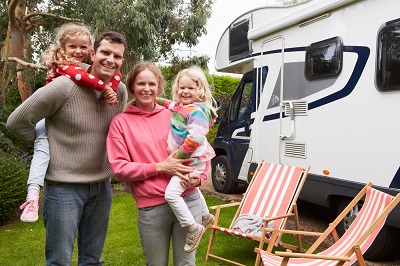
A new study, commissioned by Go RVing and RVIA and conducted by an outside, independent firm, found RV vacations cost much less than other vacation travel, even when factoring in fuel prices and RV ownership costs.
According to the study, CBRE Hotels Advisory Group found a four-person travel party that goes RVing saves an average of up to 60%. A two-person travel party saves up to an average of 46% RVing, depending on factors such as the type of RV and type of vacation, the study said.
The average cost per day for four people camping was 48% less than the average daily cost of a comparable four-person air/hotel vacation and about 34% less expensive than the average daily cost of a comparable four-person car/hotel vacation.
The study found the cost for a four-person camping vacation in a Type B motorhome was 49% less than the average daily cost of a comparable four-person air/hotel vacation and 35% less than a four-person car/hotel vacation.
“Consumers continue to place a priority on traveling and spending time with family and friends and this study confirms the fact that RV vacations are one of the most economical ways to travel,” RVIA President and CEO Craig Kirby said. “RV vacations provide freedom from many of the traditional hassles of travel, while also providing greater control over your budget.”
Researchers found fuel prices would need to rise to $21 per gallon for a four-person Type C motorhome vacation to be more expensive than a non-RV vacation.
A Type A motorhome vacation is less expensive than an upscale non-RV vacation unless fuel costs increased 350% to 375%, the study said.
According to the study, fuel costs will likely not approach the levels required to impact RV vacations’ affordability in “the foreseeable future.” Price spikes in fuel costs should not adversely affect consumers’ decisions to take an RV vacation, the study said.
The study analyzed vacation costs using two sets of hypothetical travel groups: a four-person travel party of two adults and two children, and a two-person travel party of two adults. The study compared different travel methods, including Type A, B and C motorhomes, folding camping trailers, lightweight travel trailers, traveling in a personal car and staying at hotels and traveling in a personal car or airline and staying in a rental house/condo. The study included various scenarios where vacationers ate their meals when traveling.
The study analyzes the major costs vacationers incur traveling to nine popular vacation destinations. CBRE analyzed routes and stops. For each destination, researchers analyzed vacations lasting three, seven and 14 days.
“It was important for us to look at real itineraries for travelers and quantify what real families can expect to save by choosing RVing as their preferred mode of travel,” Go RVing Chief Marketing Officer Karen Redfern said. “Beyond the cost savings, RVing also allows families the unique ability to travel whenever and wherever desired while avoiding common travel hassles and fostering an increased sense of togetherness, control, flexibility, convenience and accessibility to the great outdoors.”
Go RVing commissioned CBRE Hotels Advisory to provide an objective comparison between a summer vacation cost using RVs and other vacation costs during the same timeframe. CBRE factored in an estimated RV ownership cost based upon published data regarding average ownership periods, residual values, annual days of use, insurance and other costs of ownership, as well as any applicable tax benefits, RVIA said.
To view the full study, click here.





